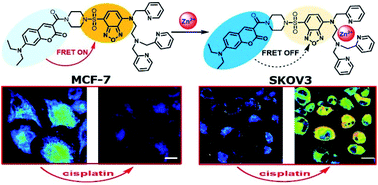A FRET-based fluorescent Zn2+ sensor: 3D ratiometric imaging, flow cytometric tracking and cisplatin-induced Zn2+ fluctuation monitoring†
Abstract
Monitoring labile Zn2+ homeostasis is of great importance for the study of physiological functions of Zn2+ in biological systems. Here we report a novel ratiometric fluorescent Zn2+ sensor, CPBT, which was constructed based on chelation-induced alteration of FRET efficiency. CPBT was readily cell membrane permeable and showed a slight preferential localization in the endoplasmic reticulum. With this sensor, 3D ratiometric Zn2+ imaging was first realized in the head of zebra fish larvae via Z-stack mode. CPBT could track labile Zn2+ in a large number of cells through ratiometric flow cytometric assay. More interestingly, both ratiometric fluorescence imaging and flow cytometric assay demonstrated that the labile Zn2+ level in MCF-7 cells (cisplatin-sensitive) decreased while that in SKOV3 cells (cisplatin-insensitive) increased after cisplatin treatment, indicating that Zn2+ may play an important role in cisplatin induced signaling pathways in these cancer cells.



 Please wait while we load your content...
Please wait while we load your content...